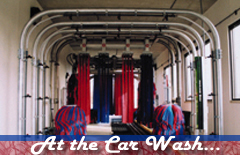It's that time of year again. Winter is approaching which means preparing your car for some nasty weather elements. If you live in snow country, you'll likely have snow tires put on to prevent your car from sliding off the road. If you live in a region where salt is used on the roads, you may consider getting an extra layer of coating to protect your undercarriage so it doesn't rust. And, with all the acid rain, road grease, and other unsavory elements that will attack your car this winter, getting a wax job to protect your paint might be a good idea.
So why do we invest so much time and money in protecting our car when winter approaches? There are a number of reasons, all of which are equally important. First off, preventative car care protects our automobiles so they last longer, also preserving resale value. Secondly, taking care of our vehicles prevents having costly repairs and frightening breakdowns. An overwhelming majority of car owners seem to know what to do, and why, when it comes to car care.
Then why is it the overwhelming majority of car owners seldom wash their cars on a regular basis? The irony here is that keeping your car clean (for under $10 every couple of weeks) has many significant financial and environmental benefits as well, especially when performed by a professional car wash.
Let's start with the financial rewards. In today's environment, on the best of days, our cars are subjected to sun, salt from the sea, road grease, dead bugs, bird poop and smog. On bad days, our cars are subjected to salt from snow trucks, acid rain, tree sap, road slush and mud.
Any one of these elements can eat away at a car's metal, chrome and paint. Corrosion will occur and rust will appear under the carriage, in wheel wells, even in parts under the hood. It may not be noticeable right away, but over time it will degrade your car, diminishing its resale value. When it comes time to sell or trade you'll be quite disappointed at how little your car is worth and how much you've lost financially. By having your car washed monthly, not only do you protect your investment and save money, you also ensure your continued freedom to go anywhere and do anything, not to mention your personal safety and security while on the road.
Did you know that nearly $24 billion a year is spent on battling car corrosion damage? This cost is absorbed by you, the consumer, in three ways; funding automakers efforts to research corrosion-resistant paints and coatings; fixing damage to your own vehicle caused by road and sea salt; or corrosion-related depreciation of cars. Go to www.corrosioncost.com/pdf/motorvehicles.pdf for more information.
There is another important reason to keep your car professionally washed, protecting the environment. In 1972, the government established the Clean Water Act, which mandated professional car washes to pipe dirty water to treatment facilities or into state-approved drainage facilities.
 Washing your car at home pollutes the environment — soap and road grime such as oils, tar, and dirt washed from your car ends up in storm sewers that flow into lakes, streams and rivers. In fact, many North American cities have even banned charity car-washing events, which result in soapy discharge and wasted water. Regardless of all the other reasons mentioned, the environmental issue should be consideration enough. After all, these lakes, streams and rivers could be those in which your children swim, or where you fish, or perhaps even live. Keeping them clean ensures a healthier future for all of us.
Washing your car at home pollutes the environment — soap and road grime such as oils, tar, and dirt washed from your car ends up in storm sewers that flow into lakes, streams and rivers. In fact, many North American cities have even banned charity car-washing events, which result in soapy discharge and wasted water. Regardless of all the other reasons mentioned, the environmental issue should be consideration enough. After all, these lakes, streams and rivers could be those in which your children swim, or where you fish, or perhaps even live. Keeping them clean ensures a healthier future for all of us. Another consideration is this: a professional car wash uses about 32 gallons per car. Studies have shown that a 45-minute car wash at home can use more than 300 gallons of water. Who pays your water bills?
Treat your car the way you want it to treat you. Add a professional car wash to your monthly chores. With some 75,000 professional car washes nationwide, there's just no excuse to skip it. And bring the kids. They're never too young to start learning the value of good auto maintenance, inside and out.
For more information see Road and Travel.









